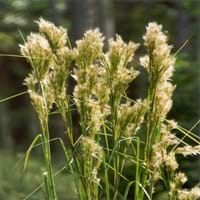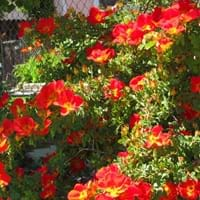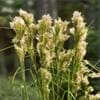Life Span
Perennial
Perennial
Type
Grass
Flowering Plants, Ornamental Plants, Shrubs
Origin
Caribbean, Central America
Not Available
Types
Broomsedge Bluestem, Broomsedge
Not Available
Number of Varieties
Not Available
Habitat
ditches, Grassland, Moist Ditches, Moist Soils, Roadsides
Foot Hills
USDA Hardiness Zone
5-9
Not Available
AHS Heat Zone
10 - 5
Not Available
Sunset Zone
H1, 3a, 3b, 4, 5, 6, 7, 8, 9, 14, 15, 16, 17, 18, 19, 20, 21, 22, 23, 24
Not Available
Habit
Upright/Erect
Clump-Forming
Flower Color
Cream, Green, White
Orange Red, Yellow
Flower Color Modifier
Bicolor
Bicolor
Fruit Color
Not Available
Non Fruiting Plant
Leaf Color in Spring
Green, Blue Green
Green
Leaf Color in Summer
Light Green
Green, Dark Green
Leaf Color in Fall
Gray Green, Yellow green, Bronze
Dark Green
Leaf Color in Winter
Gold, Tan, Bronze
Dark Green
Leaf Shape
Grass like
Pinnate
Plant Season
Fall, Winter
Spring, Summer, Fall
Sunlight
Full Sun, Partial Sun
Full Sun, Partial Sun
Growth Rate
Medium
Medium
Type of Soil
Clay, Loam, Sand
Loam, Sand
The pH of Soil
Acidic, Neutral, Alkaline
Acidic, Neutral
Soil Drainage
Average
Well drained
Bloom Time
Late Summer, Early Fall, Fall, Late Fall, Early Winter
Spring, Late Spring, Early Summer, Summer, Late Summer, Early Fall, Fall
Repeat Bloomer
No
Not Available
Tolerances
Not Available
Drought
Where to Plant?
Ground
Container, Ground, Pot
How to Plant?
Root Division, Seedlings
Cuttings
Plant Maintenance
Medium
Medium
Watering Requirements
Keep ground moist, Water Deeply
Average Water Needs
In Summer
Lots of watering
Lots of watering
In Spring
Moderate
Moderate
In Winter
Average Water
Average Water
Soil pH
Acidic, Neutral, Alkaline
Acidic, Neutral
Soil Type
Clay, Loam, Sand
Loam, Sand
Soil Drainage Capacity
Average
Well drained
Sun Exposure
Full Sun, Partial Sun
Full Sun, Partial Sun
Pruning
Cut or pinch the stems, Remove damaged leaves, Remove dead branches, Remove dead leaves
Remove damaged leaves, Remove dead branches, Remove dead leaves
Fertilizers
All-Purpose Liquid Fertilizer
All-Purpose Liquid Fertilizer
Pests and Diseases
Red blotch
Beetles, Black Spot, Caterpillars, Downy mildew, Mosaic viruses, Powdery mildew, Rust, Scale insects, Thripes
Plant Tolerance
Drought
Drought
Flower Petal Number
Single
Double
Edible Fruit
No
Not Available
Foliage Texture
Coarse
Medium
Foliage Sheen
Matte
Glossy
Invasive
Sometimes
Not Available
Self-Sowing
Yes
Not Available
Attracts
Birds, Butterflies
Birds, Butterflies
Allergy
Not Available
Rash
Aesthetic Uses
Ground Cover
Showy Purposes
Beauty Benefits
Not Available
Not Available
Environmental Uses
Air purification, Food for animals, Food for birds, Provides ground cover, Wildlife
Air purification
Medicinal Uses
Not Available
Not Available
Part of Plant Used
Seeds
Flowers
Other Uses
Used as Ornamental plant
Oil is used in perfume, soaps, creams, etc.
Used As Indoor Plant
No
Yes
Used As Outdoor Plant
Yes
Yes
Garden Design
Container, Dried Flower/Everlasting, Feature Plant, Mixed Border, Rock Garden / Wall
Container, Cutflower, Feature Plant, Foundation, Mixed Border, Topiary / Bonsai / Espalier
Botanical Name
ANDROPOGON glomeratus
Rosa foetida
Common Name
Bushy Beardgrass, Bushy Bluestem, Bushy Broom Grass
Austrian briar, Persian yellow rose, Austrian copper rose
In Hindi
Bushy Bluestem plant
Austrian copper rose
In German
Bushy Bluestem Pflanze
Die Gelbe Rose, Fuchs-Rose, Wachs-Rose, Persische Gold-Rose, Austrian Briar
In French
plante buissonnante Bluestem
Le rosier fétide
In Spanish
planta arbustiva andropogon
Rosa foetida
In Greek
φυτό θαμνώδη BLUESTEM
Austrian copper rose
In Portuguese
planta arbustiva Bluestem
Rosa fétida
In Polish
Krzaczaste Bluestem roślin
Róża żółta
In Latin
Bushy bluestem herba
Austrian copper rose
Phylum
Magnoliophyta
Magnoliophyta
Class
Liliopsida
Magnoliopsida
Clade
Angiosperms, Commelinids, Monocots
Not Available
Tribe
Andropogoneae
Not Available
Subfamily
Panicoideae
Not Available
Number of Species
Not Available
Importance of Bushy Bluestem and Austrian Copper Rose
Want to have the most appropriate plant for your garden? You might want to know the importance of Bushy Bluestem and Austrian Copper Rose. Basically, these two plants vary in many aspects. Compare Bushy Bluestem and Austrian Copper Rose as they differ in many characteristics such as their life, care, benefits, facts, etc. Every gardener must at least have the slightest clue about the plants he wants to plant in his garden. Compare their benefits, which differ in many ways like facts and uses. The medicinal use of Bushy Bluestem is Not Available whereas of Austrian Copper Rose is Not Available. Bushy Bluestem has beauty benefits as follows: Not Available while Austrian Copper Rose has beauty benefits as follows: Not Available.
Compare Facts of Bushy Bluestem vs Austrian Copper Rose
How to choose the best garden plant for your garden depending upon its facts? Here garden plant comparison will help you to solve this query. Compare the facts of Bushy Bluestem vs Austrian Copper Rose and know which one to choose. As garden plants have benefits and other uses, allergy is also a major drawback of plants for some people. Allergic reactions of Bushy Bluestem are Not Available whereas of Austrian Copper Rose have Rash respectively. Having a fruit bearing plant in your garden can be a plus point of your garden. Bushy Bluestem has showy fruits and Austrian Copper Rose has no showy fruits. Also Bushy Bluestem is not flowering and Austrian Copper Rose is not flowering . You can compare Bushy Bluestem and Austrian Copper Rose facts and facts of other plants too.





